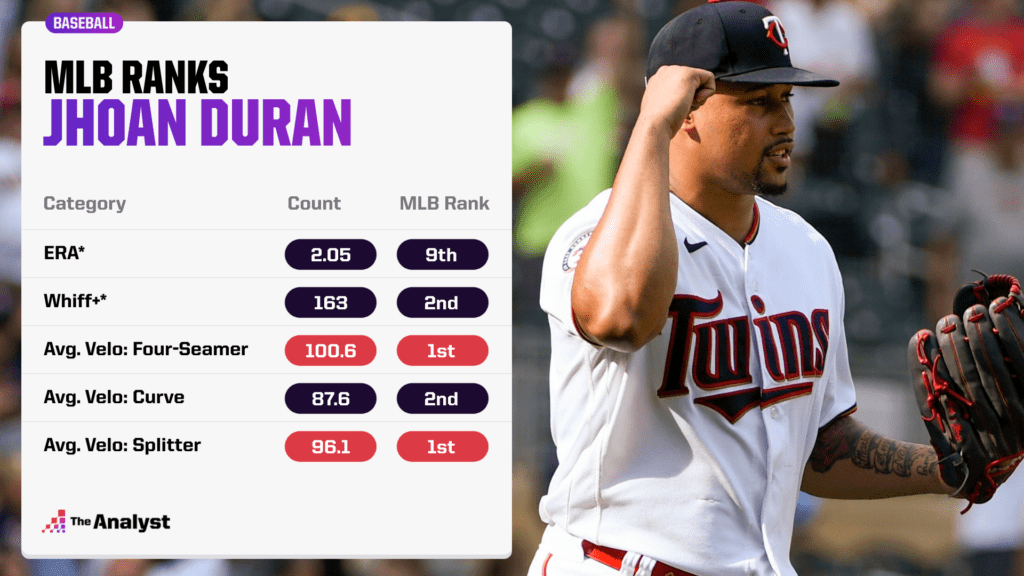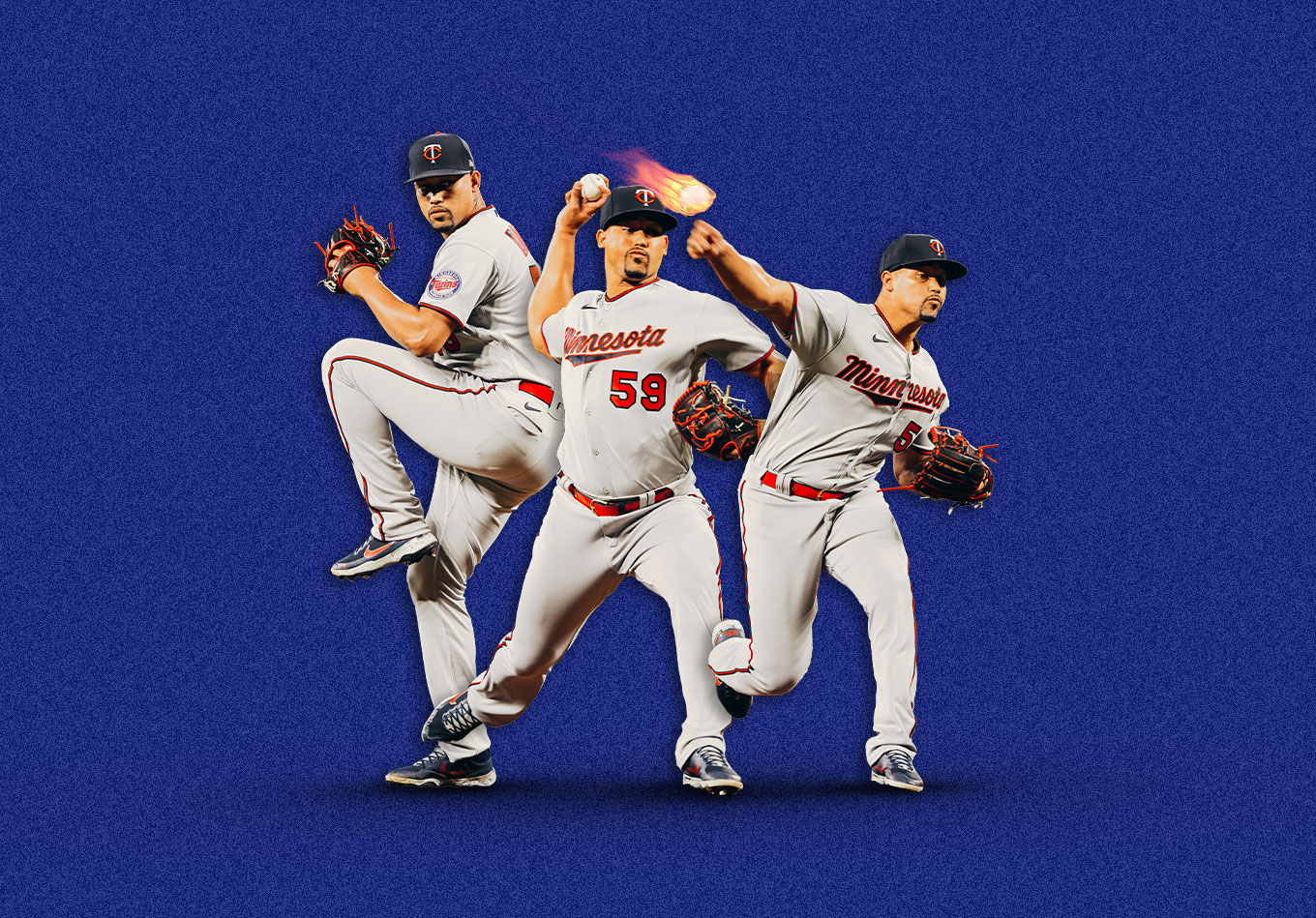Everybody loves high-velocity relievers.
Fans find them electrifying, and teams know that good velo is usually (but not always) correlated with good results on the mound. However, it takes more than just throwing the ball at 100 mph to home plate to find success.
Other factors come into play: pitch movement, control, command, secondary pitches and mindset are some of them. Reliever Jhoan Duran of the Minnesota Twins took the league by storm and quickly showcased most of those traits.
He has one of the filthiest arsenals in MLB, but first, let’s examine what he has done so far in 2022.
Duran, a former top prospect as a starter coming up through the minor league system, was deployed as a reliever to start 2022. That was likely because of the Twins depth at the time, and also because his already plus fastball could be a deadly weapon in short spurts.
It was one of the best decisions they’ve made in recent times. Duran, so far, has converted all six of his save opportunities while posting a 2.05 ERA that ranks ninth in the majors among those who have thrown at least 50 innings. He also owns a sparkling 2.80 FIP and a 1.01 WHIP across his 52.2 innings, and his 33.0% strikeout rate and 5.7% walk rate speak of his dominance in the late innings.

Duran has the stuff, but also the confidence and demeanor to embrace the challenge of pitching with the game on the line. He trusts his stuff, and more importantly, can command it. He doesn’t crumble under pressure and has displayed impressive maturity for a 24-year-old rookie.
Duran’s success goes well beyond traditional metrics. We know that the outcome of most of his at-bats is favorable, judging by his ERA and the .614 OPS that batters have against him. However, a perfect way to assess the performance of every pitch that leaves his hand is raw value- (RV-).
RV- evaluates pitching performance in a comprehensive way, using elements such as launch angle and exit velocity – they get credit for coaxing hitters to make weak contact on the ground, for example – but also gauging the quality of his stuff to gets swings and misses or freezing a hitter with a backdoor two-seamer on a 3-2 count.
For RV-, 100 is average: lower is better for pitchers. The stat also exists for hitters, but it is measured using RV+, and higher is better.
Having said this, let’s look at Duran’s RV-. At 51 (heading into Friday’s games), it’s tied for fifth in MLB among those with at least 50 innings, behind only Ryan Helsey of the St. Louis Cardinals (28), Scott Effross of the New York Yankees (34), Emmanuel Clase of the Cleveland Guardians (39) and Penn Murfee of the Seattle Mariners (42).
Command+ tries to determine the rate with which a pitcher executes his plan. In other words, whether he accomplishes his goal with every pitch. Whiff+ tells the story of how good a hurler is at generating swings and misses with his stuff. Again, for all of these, 100 is considered average, and higher is better.
Duran rates favorably in all three stats. He has an average 100 command+, though that’s impressive for someone who throws 100-plus mph. Of pitchers who have thrown at least 50 innings, only six have a plus-130 whiff+ and above-average command+. Duran ranks second in MLB with a 163 whiff+ and seventh in percentage of opponent swings that miss (33.9).
Now, let’s take a deeper look at his stuff, which is what you would call ‘overpowering.’ Duran throws mainly three pitches: a four-seam fastball (47.4% of the time), a curveball (36.5%), and a splitter (13.0%). He rarely goes to his slider (3.1%).
Each and every one of the three pitches he throws regularly rank either first or second in average velocity. His four-seamer is the hardest in MLB on average at 100.6 mph (!) and his splitter also ranks first at 96.2.
The curveball, at 87.6 mph on average, is second in the league behind Joe Kelly of the Chicago White Sox (87.8).
It’s a nasty offering, a true hammer that is almost impossible to hit:
All three pitches are above average in strike+ and whiff+, with the curveball being particularly effective (170 whiff+, 36 RV-).
The splitter is the “worst” of the three, yet still has a 97 RV- (better than average) despite a .403 wOBA.
Because of his three-pitch mix and its obvious quality, Duran doesn’t have a platoon split as he dominates lefties and righties. The former have a .609 OPS against him, while the latter have a .617 mark.
Duran has a plan to attack both lefties and righties, and he’s successful most of the time. He’s not afraid to go to any of his three main offerings on the first pitch, but likes to start off lefties with the four-seam (59.4%) targeted up and away or down and away. With two strikes against them, the curve becomes more of a factor (35.5%) while the splitter drops to 12.1%. He still throws the four-seamer (targeted high) at 50.8%, but also loves the hook targeted down, below the zone, to get the hitter to chase.
Against right-handed hitters, Duran can use a variety of pitches to open at-bats, even mixing in more sliders (11.6%). Since he can go to the splitter (17.0%), curveball (28.6%) and the four-seamer (42.9%), hitters can’t know what’s coming.
When he gets to two strikes against righties, he prefers to bring on the heat (41.1%) up and out of the zone or low and away, but is almost equally likely to throw a curveball (41.1%) down and away. It’s a difficult guessing game for an opposing batter and the recipe for success for Duran – one that has worked to perfection.
One would think that Duran would start getting tired at this point, but he’s only one earned run allowed in 10.2 innings after the All-Star break, with 18 strikeouts. If you were wondering, that’s good for an 0.84 ERA.
Duran is not only one of the best and most overpowering relievers in the American League already, but he’s also one of the game’s most exciting pitchers overall. He’s competitive, he throws hard and he has a plan and ideas on how to execute it.
He’s a true stud and a franchise cornerstone for the Twins.
